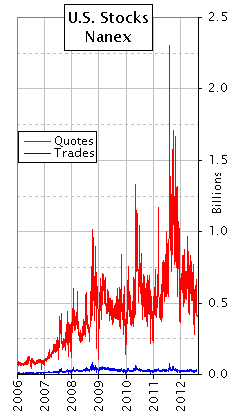High Frequency Trading Doesn't Harm Investors and Other Absurdities
From Nanex:
From the 1990's through the end of 2006, electronic trading increased transparency which
attracted liquidity, leading to to narrower spreads and greater market stability.
The graphic in this recent
New York Times article shows the steady reduction in trading costs
up until about 2006. Since that time, trading costs have
not changed significantly
on the execution side but on the analysis side (not factored into the New York Times
article), both the number of quotes
and the cost
of receiving and processing them has exploded.1 Spreads
have also become considerably
less stable.
The benefits, but not the higher costs, are claimed by
High Frequency Trading (HFT) proponents, who paint
HFT critics as Luddites. This is often accompanied by hysterical charges of wanting to take
the industry back
to specialists and floor trading, and comparisons to buggy whip manufacturers. Nothing can be further from the truth.
The choice is not between HFT and floor trading, the choice is between HFT and transparent
electronic trading.
Transparency means having more (accurate) information to make informed decisions. For
example, you can determine the stability of a stock quote by comparing the price
quoted with the price received. Transparency also means having more choices and knowing
the consequences of those choices: such as the choosing which exchange to send your
stock order and then knowing how the order was executed. As far as the investor is concerned,
market transparency has a long way to go. Consider:
Amazon gives you more information about a $20 order than your broker
gives you about a $20,000 stock trade.
And if you only knew where your stock order went....MORE

